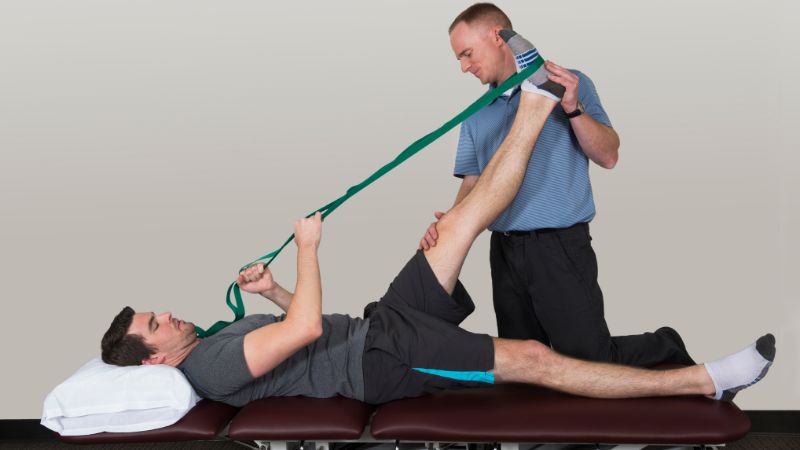Living with chronic pain can be physically exhausting and emotionally draining, impacting every aspect of daily life. While medications offer temporary relief, they often come with side effects and do not address the underlying causes of pain. This is where physical therapy shines as a holistic approach to managing chronic pain. By focusing on rehabilitation and improving physical function through targeted exercises and therapeutic techniques, physical therapy offers a range of benefits that go beyond mere symptom relief.
These Key Benefits of Physical Therapy for Chronic Pain Management include enhanced mobility, improved strength, personalized treatment plans, and long-term pain reduction strategies. Through education and personalized care, physical therapists empower individuals to take control of their pain and regain their quality of life effectively.
Key Benefits of Physical Therapy for Chronic Pain Management
Pain Reduction and Management

Physical therapy plays a crucial role in reducing and managing chronic pain by addressing its root causes through various therapeutic interventions. Unlike medications that primarily mask symptoms, physical therapists aim to understand the source of pain and develop personalized treatment plans. Exercises, manual treatment, and modalities like heat or cold therapy are frequently included in these schemes. Through targeted exercises, therapists help improve flexibility, strengthen muscles, and enhance joint mobility, thereby alleviating pain over time. They also educate patients on pain management techniques they can apply independently, empowering them to actively participate in their own recovery. By focusing on long-term pain reduction rather than short-term relief, physical therapy offers sustainable solutions that contribute to improved quality of life.
Improved Mobility and Flexibility
Chronic pain frequently leads to decreased mobility and flexibility, affecting daily activities and overall well-being. Physical therapists employ stretching exercises, joint mobilization techniques, and specialized movements to restore range of motion and improve flexibility. These interventions target specific muscle groups and joints affected by pain, gradually increasing mobility and reducing stiffness. Improved flexibility not only enhances physical function but also reduces the risk of future injuries by promoting proper body mechanics and alignment. By incorporating mobility-enhancing exercises into personalized treatment plans, physical therapists empower individuals to regain independence in movement and experience less discomfort during daily activities.
Enhanced Strength and Conditioning
Weak muscles often contribute to chronic pain by placing additional stress on joints and tissues. Physical therapists design strength training programs tailored to individual needs, focusing on strengthening muscles around affected areas. These exercises improve overall strength, stability, and endurance, which are essential for supporting joints and reducing pain. By targeting specific muscle imbalances and weaknesses, therapists help restore optimal function and prevent recurrent pain episodes. Strength training in physical therapy not only promotes healing but also builds resilience against future injuries, supporting long-term pain management and improving overall physical fitness.
Education and Self-Management
Understanding the underlying causes of chronic pain is fundamental to effective management. Physical therapists educate patients about their condition, anatomy, and how specific exercises and techniques contribute to pain relief and functional improvement. They teach self-management strategies such as proper body mechanics, ergonomic principles, and home exercises that empower individuals to manage their pain independently. Education fosters a proactive approach to health, enabling patients to make informed decisions and adopt healthy lifestyle habits that support long-term well-being. By promoting self-awareness and providing the necessary tools for self-care, physical therapists play a critical role in empowering individuals to take control of their pain and optimize their quality of life.
Non-Invasive Treatment Option

Physical therapy offers a non-invasive alternative to managing chronic pain, emphasizing natural healing methods over invasive procedures or surgeries. Therapists utilize gentle techniques such as manual therapy, therapeutic exercises, and modalities like ultrasound or electrical stimulation to alleviate pain and promote tissue healing. This approach reduces the risks associated with invasive interventions while providing effective pain relief and functional improvement. Non-invasive treatments in physical therapy are particularly beneficial for individuals seeking conservative options or those who may not be suitable candidates for surgery. By focusing on the body’s innate healing abilities, physical therapy supports comprehensive pain management strategies that prioritize safety, effectiveness, and patient comfort.
Also Read: 9 Benefits of physical therapy for postural restoration
Holistic Approach to Wellness
Chronic pain impacts not only physical health but also emotional and psychological well-being. Physical therapists take a holistic approach to wellness by addressing the interconnected aspects of pain management. They incorporate techniques such as relaxation exercises, mindfulness training, and stress management strategies to reduce emotional distress and improve overall mental health. By addressing the psychological components of pain, therapists help individuals cope more effectively and enhance their resilience. This holistic approach fosters a positive mindset and supports comprehensive recovery, empowering patients to achieve optimal physical and emotional well-being.
Personalized Treatment Plans
Every individual experiences chronic pain differently, necessitating personalized care plans tailored to their specific needs and goals. Comprehensive evaluations are performed by physical therapists to determine the root causes of pain and functional impairments. Based on these assessments, they develop customized treatment strategies that may include a combination of therapeutic exercises, manual therapy, and patient education. Personalized treatment plans ensure that interventions address each patient’s unique challenges, maximize therapeutic outcomes, and promote long-term success. By adapting treatment approaches to individual responses and progress, physical therapists optimize rehabilitation efforts and empower patients to achieve meaningful improvements in pain management and overall function.
Long-Term Pain Management
The ultimate goal of physical therapy in chronic pain management is to achieve sustainable, long-term pain relief and functional improvement. Unlike temporary solutions, such as medications or short-term interventions, physical therapy focuses on addressing the underlying causes of pain and enhancing physical function. Therapists work collaboratively with patients to establish realistic goals and develop strategies that support ongoing pain management. Through progressive rehabilitation and patient education, physical therapy promotes habits and behaviors that contribute to sustained wellness and reduced reliance on pain medications. By empowering individuals with the skills and knowledge to manage their pain effectively, physical therapy fosters independence and supports a higher quality of life over the long term.
Improved Quality of Life

Physical therapy significantly enhances quality of life for individuals living with chronic pain by reducing symptoms, improving function, and restoring independence. By alleviating pain and enhancing physical capabilities, therapy enables patients to engage more fully in daily activities, work, hobbies, and social interactions. Improved mobility, strength, and self-management skills contribute to greater confidence and satisfaction in daily living. Physical therapists play a pivotal role in supporting patients’ overall well-being by addressing the multifaceted impacts of chronic pain and promoting holistic recovery. By focusing on comprehensive rehabilitation and empowering patients to take an active role in their health, physical therapy helps individuals regain control, achieve their goals, and enjoy a fulfilling life free from debilitating pain.
Conclusion
Physical therapy stands as a cornerstone in the effective management of chronic pain, offering a multifaceted approach that addresses both the symptoms and underlying causes. Through targeted exercises, personalized treatment plans, and holistic strategies, physical therapists empower individuals to regain mobility, reduce pain, and improve overall quality of life. By focusing on long-term solutions rather than temporary relief, physical therapy not only alleviates immediate discomfort but also builds resilience against future challenges. Education and self-management play pivotal roles, equipping patients with the knowledge and tools to actively participate in their recovery journey. Ultimately, physical therapy promotes independence, enhances physical function, and fosters a positive mindset, enabling individuals to reclaim their lives from chronic pain.
FAQs
How soon can I expect to see results from physical therapy for chronic pain?
Results vary depending on individual conditions and adherence to the treatment plan. Some patients experience improvement within a few weeks, while others may require longer-term therapy for significant relief.
Is physical therapy painful for chronic pain patients?
Physical therapy is tailored to each patient’s tolerance levels and aims to alleviate pain rather than exacerbate it. Therapists use gentle techniques and adjust treatment plans as needed to ensure comfort and effectiveness.
Can physical therapy completely eliminate chronic pain?
While physical therapy can significantly reduce chronic pain and improve function, complete elimination depends on factors like the underlying condition, patient adherence, and overall health. Therapy aims to manage and minimize pain to enhance quality of life effectively.





